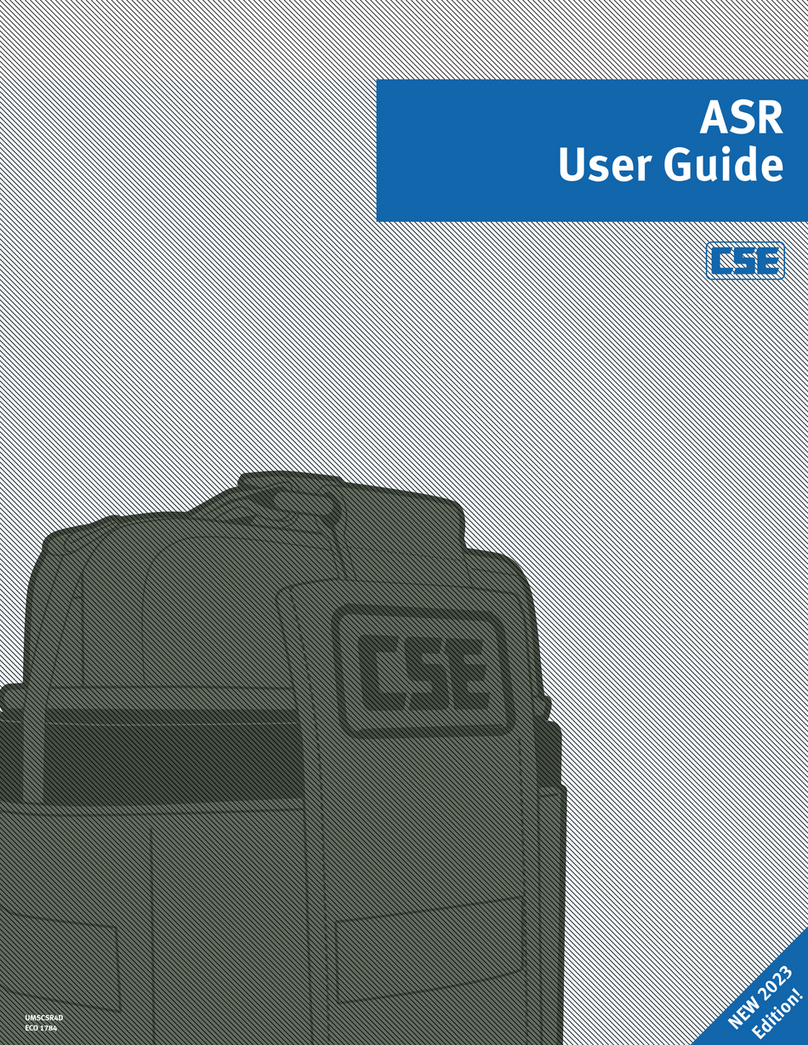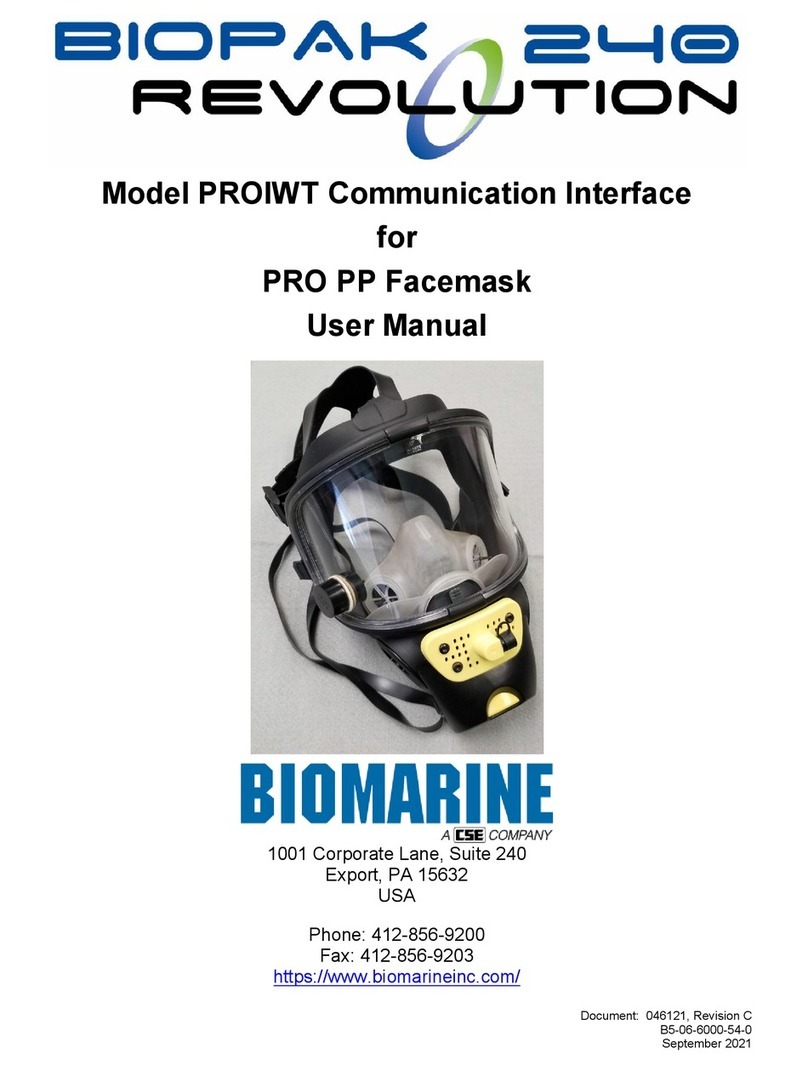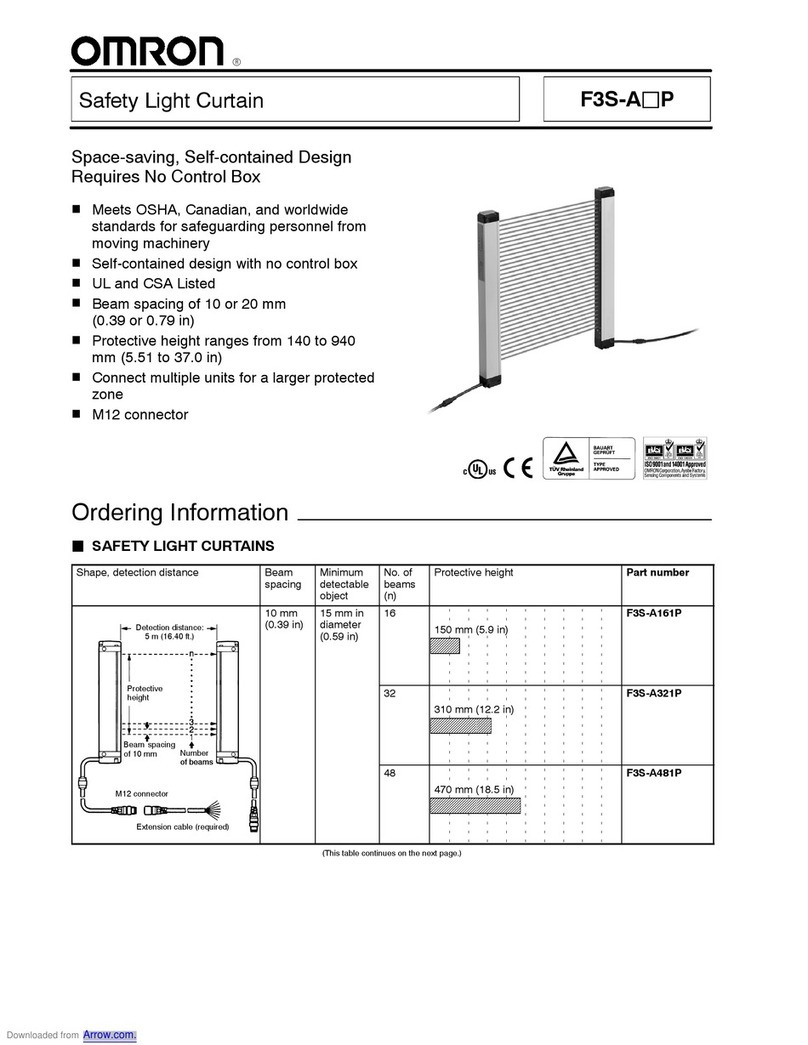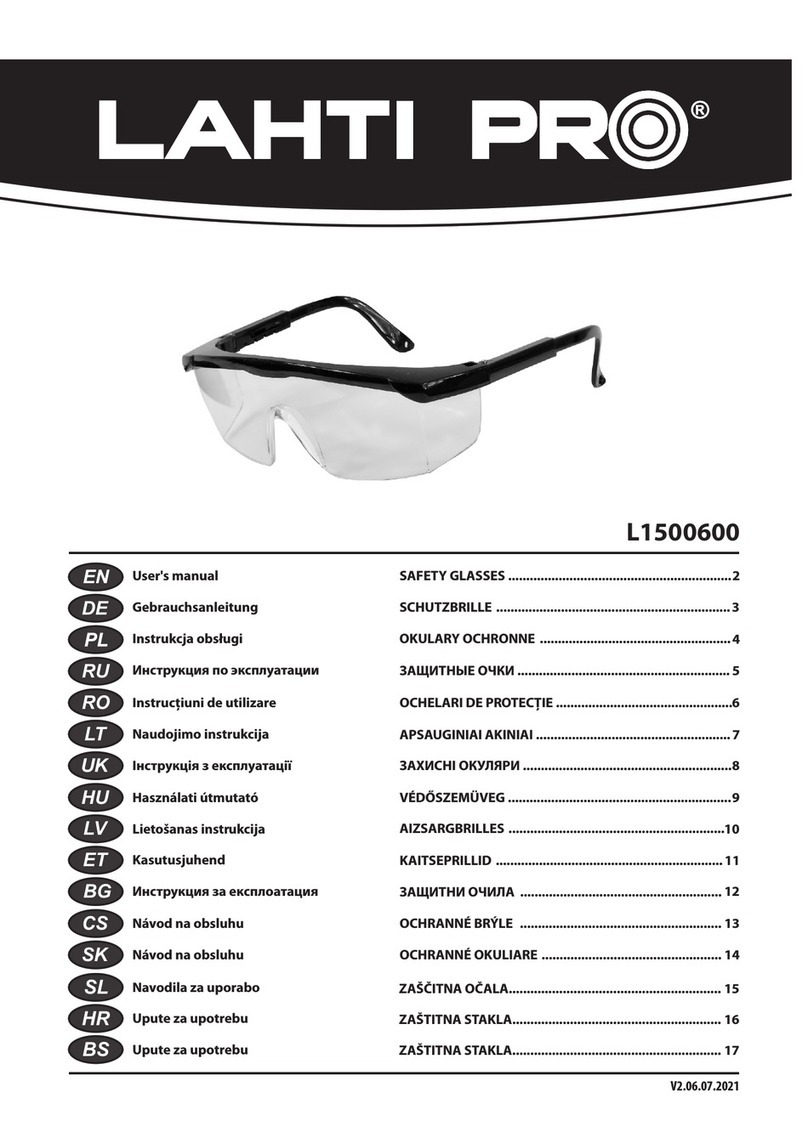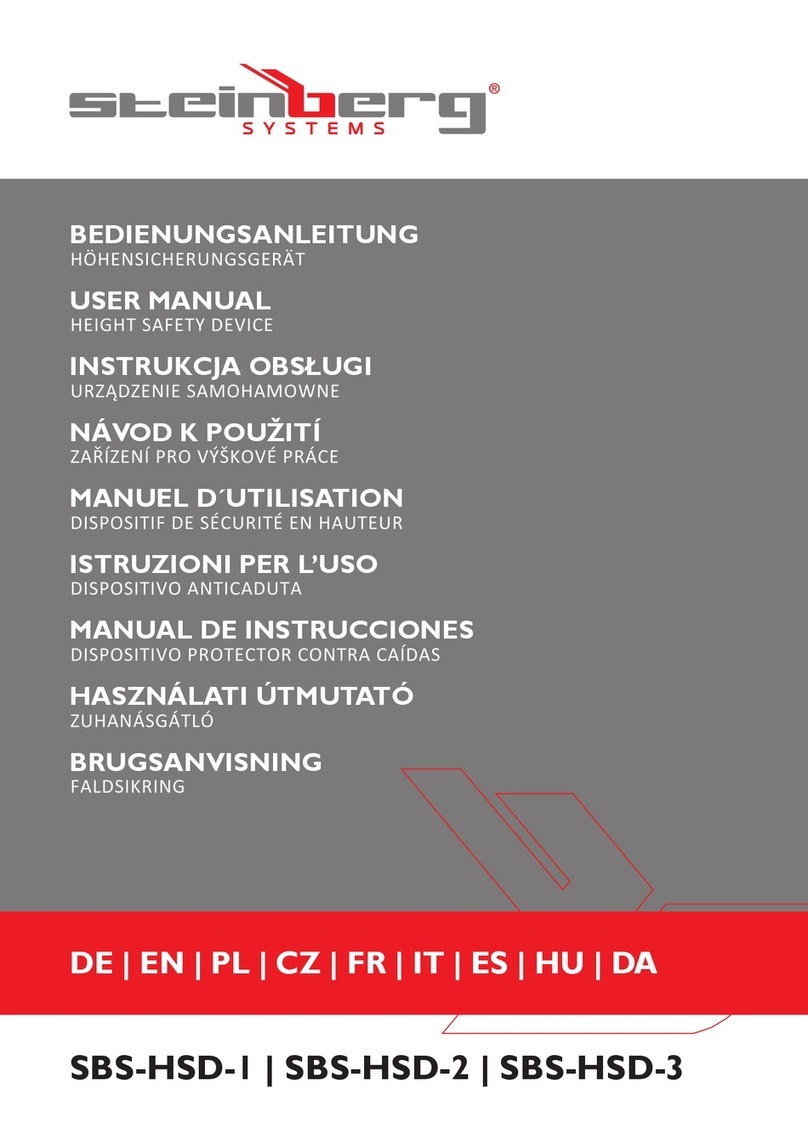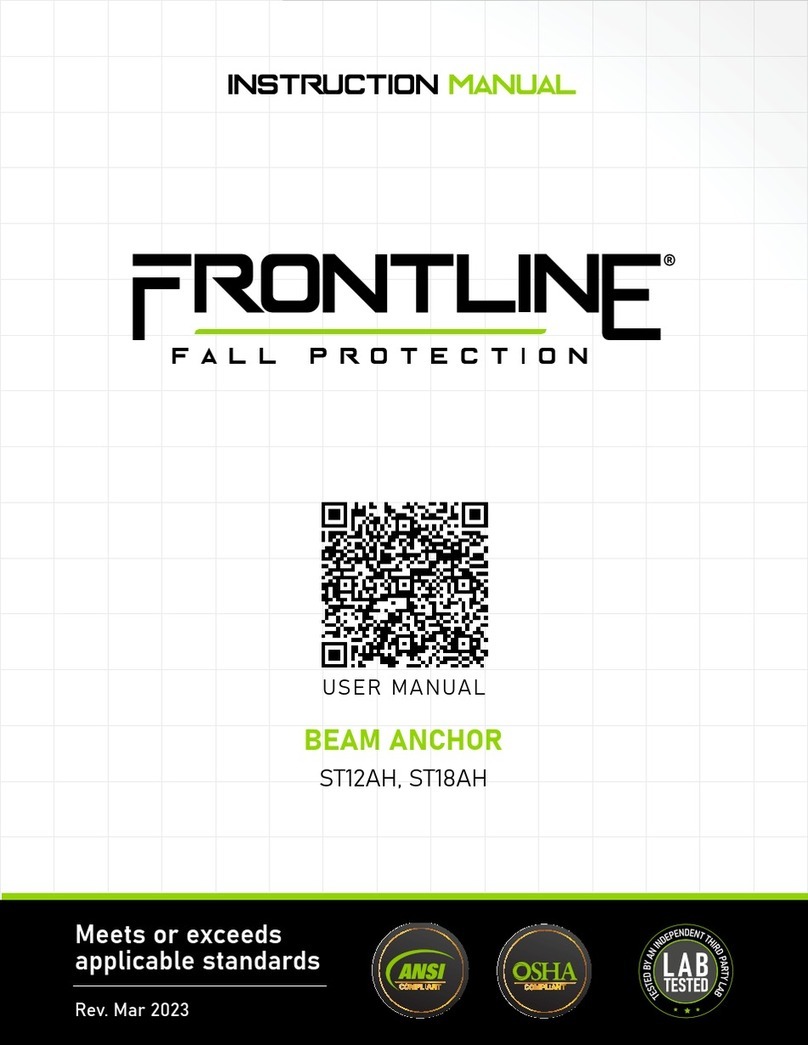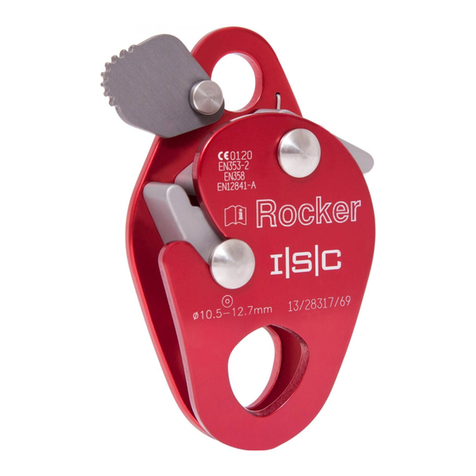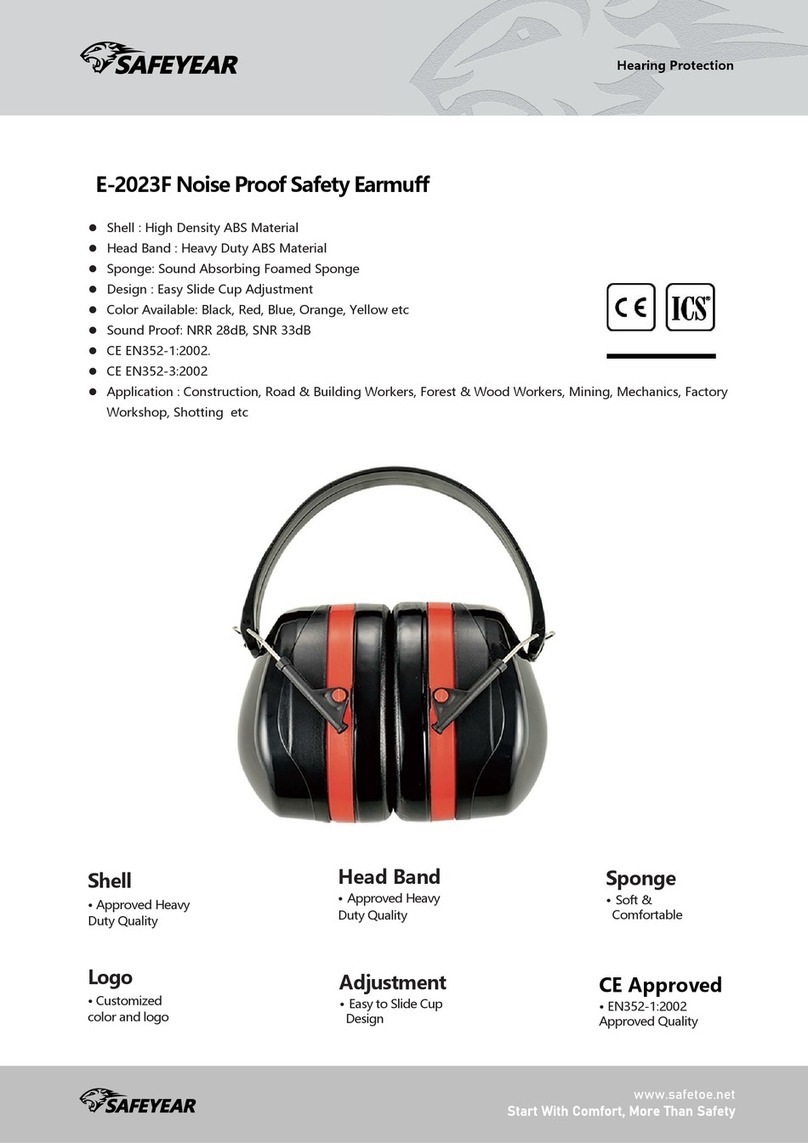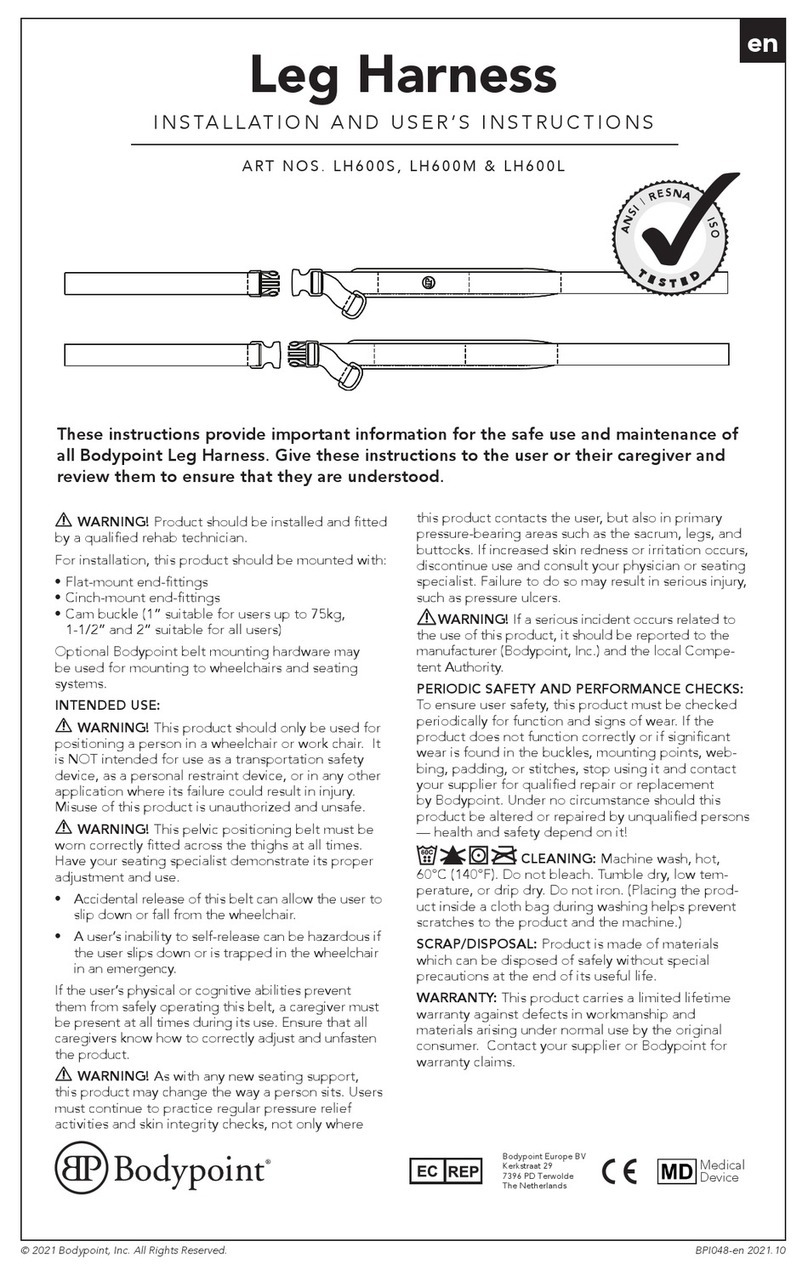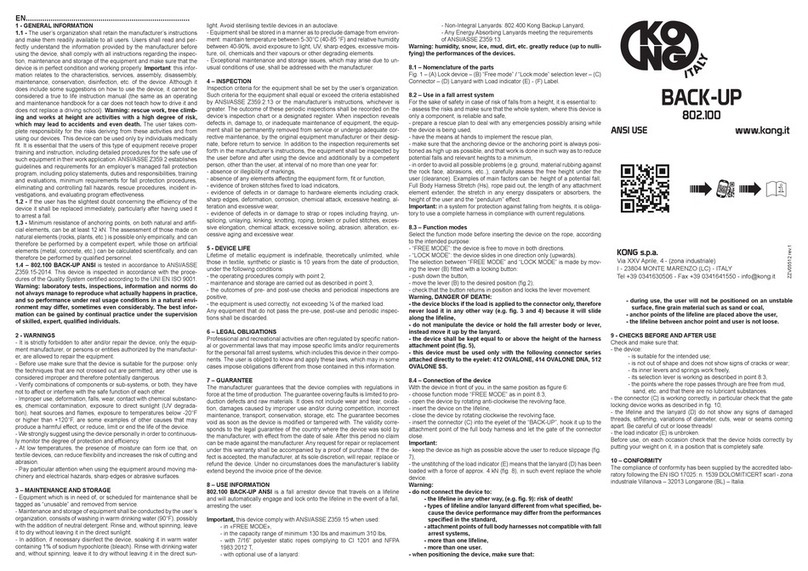CSE SCSR Installation guide

SCSR
Training
UMSCSR1A

KEY
indicates a hazardous situation that,
if not avoided, will result in death
or serious injury.
indicates a hazardous situation that,
if not avoided, could result in death
or serious injury.
indicates a hazardous situation that,
if not avoided, could result in minor
or moderateinjury.
CONTENTS
1 Summary
3 Preparing to Train
9 The CSE SCSR System
11 SCSR Basics
Donning
Changeover
Manual Start
21 Training with the SR-MP
27 Training with the SR-T
37 Training with the SR-D
44 Training Announcement Poster
45 Training Roster

CSE SCSR TRAINING December 2011 Do not remove or discard this page.
1
This
page is
important
for
Summary
Taking the Unexpected Out of SCSR Use
This section of the CSE SCSR Manual is intended primarily for
trainers, but miners and safety personnel will find it useful, too.
These pages will help you understand and explain:
How the SCSR and the CSE training deviceswork
What it’s like to use them
Why it’s important to follow the SCSR user
instructions exactly, every time
We’ve included suggestions for getting your class organized,
conducting it eectively, and cleaning and storing training
devices when the class is over. All of this information is based
on experience in the field. We hope it will make your training
duties easier.
TRAINERS | MINERS | SAFETY PERSONNEL


CSE SCSR TRAINING December 2011 Do not remove or discard this page.
3
This
page is
important
for
Preparing to Train
Teaching Miners to Use the SCSR
Showing the people you work with how to practice with CSE
training devices may be the most serious assignment you’ll ever
get. Information and preparation are the keys to completing
that assignment safely and successfully.
Your personal experience, backed up by this manual and CSE’s
Self-Contained Self-Rescuer Training Program DVD, will supply
the information you need.
But preparation is a job in itself— and it takes time and eort.
Since every company has its own needs, and every trainer
develops an individual approach, there’s no universal set of
best practices. The CSE training team has, however, collected
a series of tips and techniques that work well under mining-
industry conditions. We hope you’ll find the next few pages
useful—especially if, for you, training is a new experience.
Sight, Hearing, and Touch
Research shows that three days after they’ve undergone
training, people remember only about percent of what
they’ve heard, and percent of what they’ve seen. But they
remember percent of what they’ve both heard and seen.
And when they’ve not only heard and seen that material, but
also done some physical practice, retention is evenhigher.
TIPS
CLASSROOM SETUP
• Makesurethere’senough
lightandcool,freshairto
keepyourtraineesawake.
• Taketimetoorganizeand
unclutterthepartofthe
roomthatwillbeyourbase
duringyourclass.
• Provideavideomonitor
andDVDplayer,andtestthe
setupbeforeyourclass.
• Arrangeforaflipchart,
blackboard,ormarkerboard,
withmarkersorchalk.
TRAINERS |MINERS |SAFETY PERSONNEL

CSE SCSR TRAINING December 2011 Do not remove or discard this page.
4
This
page is
important
for
How to Get Started
In the days before the class, you’ll have a few administrative
issues to take care of, supplies and support to arrange, and a
little homework todo.
Administrative Issues
Decide as soon as possible where you’re going to do your training.
If you need a classroom, find a space that’s large
enough and quiet enough for effective learning. Make
sure there’s seating, at least one table, a video monitor,
and a DVD player. A marker board or flip chart will help
you show or spell out what you’re talking about.
If in-the-mine or tailgate training makes more sense,
coordinate with foremen or supervisors to avoid
conflicts and traffic problems.
Schedule your class for the start of a shift or right after a break.
Allow enough time to cover what you need to teach
without rushingit.
If you haven’t taught the material before, estimate the
length of your class by timing yourself while you
rehearse. Add time for trainee practice and Q & A.
Let your trainees and their foremen know about the class a
few days ahead of time. Follow up with a reminder a day or
two before the class. You may want to post copies of the poster
supplied on Page , or ask your foremen to make pre-shift
announcements.
If yours is a big operation, schedule more than one class, so
every miner on every shift can make it.
A dozen trainees per class is a practical average size.
Larger classes make it hard for everyone to participate,
and for you to make sure that everyone understands
and practices.
Assign each trainee or work team to a specific session, but
announce the dates and times of other classes so there’s a
fallback plan if some can’t make the assigned time slots.
TIPS
MATERIALS FOR TRAINEES
• Preparehandoutsthatrelateto
yourtrainingtopic(seePage5).
Distributethemattheendof
theclass,tokeepattention
focusedontrainingactivities.
• Giveeachtraineeasmall
notepadandpencilto
encouragenote-takingand
emphasizethevalueof
theclass.
SAFETY PERSONNEL | MINERS | TRAINERS
Preparing to Train

CSE SCSR TRAINING December 2011 Do not remove or discard this page.
5
This
page is
important
for
Supplies and Support
Make sure you have enough training devices, including
interchangeable parts such as mouthpieces and noseclamps.
One SR-D or SR-T training device for every two trainees
is a minimum for saving time and keeping
traineesfocused. Provide one SR-MP per trainee.
If you need additional training devices or parts, check
with your company or your local CSE representative,
or see the CSE Products Guide.
Call for backup.
A CSE trainer may be available to work with you
before or during your class.
Check with your local CSE representative a few days
before your class.
Prepare training handouts.
Copies of pages from this manual (either photocopied
or downloaded from csecorporation.com) will help your
trainees understand and remember what you teach.
You may want to add safety information specific to
your company, or copies of trade magazine articles or
news stories.
Homework
Refresh your knowledge.
Review the appropriate pages in this manual.
Watch the relevant segment or segments on the
CSESelf-Contained Self-Rescuer Training Program DVD.
It shows how the lessons in this manual apply in real
life, and it will help you prepare for questions.
Rehearse your class.
First, find a quiet place and read all the material you’re
going to cover (pages from this manual, for instance)
out loud. That will give you some practice, plus a rough
idea of the time your class will take.
Outline the points you’re going to present. On the day
of the class, you’ll want to work informally from your
outline, instead of reading the manual. That way you
can hold everyone’s attention and be sure that your
message is getting through.
Practice acting out your class until you’re comfortable
covering all the material. Ask a friend or family
member to stand in for your audience, raise questions,
and give you feedback.
TIPS
PROFESSIONALATTITUDE
• Keepawayfrompolitics,
especiallycompanypolitics.
Ifatraineeinsistsonhearing
youropinion,onesafe
answeris,“Myopinionisthat
I’mnotheretotalkabout
myopinions.”
• Don’tdominatethe
conversation.Allowplenty
ofopeningsforinteraction
andfeedback.
• Keepcool.Catchyourselfif
youfeellikeover-reacting
orgettingdefensive.
• Neverusesarcasm.
• Don’tstandforhorseplay.
Alittlehumorisagoodthing,
butremindthegroupthat
traineeswhoclownaround
mayendangertheirbuddies’
lives,andtheirown,inan
emergency.
Preparing to Train
TRAINERS |MINERS |SAFETY PERSONNEL

CSE SCSR TRAINING December 2011 Do not remove or discard this page.
6
This
page is
important
for
It Pays to Be Prepared
On the day of the class, your preparation will pay o. You’ll be
able to concentrate on presenting an orderly, eective, low-
stress training session, especially if you follow an agenda like
this one:
Take Charge
Start on time. Your students won’t take your training
seriously unless you do.
Begin by introducing yourself, outlining what you’re
going to cover, and telling your trainees what your
company expects them to get out of the class.
Call the roll. Your company will want you to keep track of
which miners have been trained on which devices. You
may want to use a copy of the training roster on Page.
First Watch, Then Practice
Show the relevant segments of the CSE Self-Contained
Self-Rescuer Training Program DVD before you begin
hands-on training.
Demonstrate a training device for the whole class by
choosing one volunteer and coaching him or her in
performing the hands-on training steps described later
in this manual.
After your one-on-one demonstration, break the
class into teams of three or four. Distribute the
training devices and have them coach each other as
they practice. Make sure that you see every trainee
performing the training steps correctly at least once.
Correct them firmly when they make mistakes or fail to
follow procedures.
ANSWERINGQUESTIONS
• Invitequestionsallduringthe
class,andagainattheend.
Trainingismoreeectivewhen
everyoneparticipates.
• Acceptquestionsinanopen,
friendlyway.Neveranswer
withaput-down.
• Listencarefully,thenrestate
thequestiontobesurethat
youunderstanditandthat
thewholeclasshasheardit.
IFYOU’RESTUCKFOR
AN ANSWER
• Don’tfakeit.Ifyoudon’thave
ananswer,justsaysomething
like,“That’sagoodquestion—
gladyoubroughtitup.I’llnd
outandgetyouallananswer
rightaway.”
• Lateron,youcanreferto
thismanualoraskyourlocal
CSErepresentative.
TIPS
Preparing to Train
SAFETY PERSONNEL | MINERS | TRAINERS

CSE SCSR TRAINING December 2011 Do not remove or discard this page.
7
This
page is
important
for
Wrap It Up
When everyone has mastered the hands-on practice,
ask your trainees what they thought of the class.
Don’t feel bad if they’re critical, and don’t get drawn
into a debate. Note their comments and use them to
improve your next class.
Give your trainees a verbal pat on the back for
participating. Positive reinforcement makes training
more memorable, and encourages better participation
next time.
Finish on time. Running late won’t win you any friends
among miners, foremen, or supervisors.
You Always Have Backup
If you need more information, just ask the CSE team. Call
or , or contact us at csecorporation.
com/contact-us. We’ll be glad to hear from you, and we’ll get
you the facts as quickly as possible.
Good luck!
TIPS
ASKINGQUESTIONS
• Whenyouputaquestionto
thewholeclass,waitafew
secondsbeforeaskingitagain
oransweringityourself.Inthat
time,youmayspotatrainee
who’sonthevergeofanswering.
• Trynottoanswertoomany
ofyourownquestions.
• Ifthetraineesaren’teagerto
speakup,getthemodead
centerbyaskingsomeone
youknowaspecicquestion,
suchas,“[Name],wheredo
youndthemanufacturing
dateonanSCSR?”
• Spreadtheattention.Ask
everyoneintheclassatleast
onespecicquestion,suchas,
“[Name],whichcomesrst—
removingthemouthpieceplug
orpullingthestartertag?”or
“OntheSRLD,whatdoesa
bluemoistureindicatormean?”
• Encouragequiettraineesto
speakup—ifyouthinkthey
mighthaveanswers—likethis:
“Youknowallaboutthat,
[Name].Tellus…”
Preparing to Train
TRAINERS |MINERS |SAFETY PERSONNEL


CSE SCSR TRAINING December 2011 Do not remove or discard this page.
9
This
page is
important
for
The CSE SCSR System
Concentrating on Escape
Remember your first day on the job? The darkness, the noise,
the tight spaces? You ran into some surprises, but you had time
to get over them.
Now picture yourself as a beginner once again. But this time
you’re really under pressure: You have to don your SCSR
and find your way to safety while the air around you is full
of smoke or toxic gases.
You’ll be wearing your SCSR for a while, so forget about
breathing through your nose; it’s clamped shut. Your teeth
are gripping a rubber mouthpiece. Breathing is more work
than you’re used to. And the oxygen you inhale is starting
to warmup.
You can’t let these sensations distract you from your main job:
escaping to safety. That’s why the CSE team has developed a
family of training devices that will help you understand just
what using an SCSR is like—before you have to depend on it.
Knowing What to Expect
CSE oers three hands-on training devices. Each will help you
practice an important part of the SCSR experience. This section
of the CSE SCSR Manual will show you how to practicewith:
The SR-MP, which will help trainees get used to the
SCSR mouthpiece and the breathing resistance and
heat they would feel when using an SCSR toward the
end of its operating duration.
The SR-T, which will help trainees find out how it feels
to use an SCSR in general, and how to start an SCSR
manually in an emergency.
The SR-D, which will help trainees learn how to don,
start, and move around with an SCSR.
These instructions apply to both of the CSE SCSR models you
might see on the job: the black SRLD and the orange SR-.
The SCSR Model SRLD
(Self-Rescuer Long-Duration)
SR-MP
SR-T
SR-D
TRAINERS | MINERS | SAFETY PERSONNEL


CSE SCSR TRAINING December 2011 Do not remove or discard this page.
11
This
page is
important
for
SCSR Basics
Skills for Survival
When an emergency surrounds you with smoke or toxic gases,
you have to be ready to don your self-contained self-rescuer
(SCSR) correctly. This section will show you how to:
Don and use the CSE SCSR under ordinary conditions
Change over from one SCSR to another if you need more
than one unit to reach safety
Perform a manual start if your SCSR’s starter oxygen
supply escapes through your mouthpiece while you are
donning the unit
How an SCSR Works
All SCSR models manufactured by CSE operate the same way.
They recycle the user’s exhaled breath by chemically removing
carbon dioxide and adding oxygen. Unlike oxygen tanks and
SCUBA-type equipment, this system is simple to operate, and it
makes possible devices so lightweight and compact that you can
conveniently carry one on your belt.
From the moment you don an SCSR, you must isolate your
airway—keep all of your breath inside the system—by:
Maintaining an airtight fit between your lips
and your mouthpiece
Clamping your nose shut
The idea is to let no breathable air out, and no smoke or toxic
gases in. Your exhaled air should go only into the SCSR’s
chemical bed, activating it to produce the oxygen you need. If you
remove your mouthpiece, your oxygen will escape. Never take
your mouthpiece out to talk or for any other reason unless you
are changing over to another SCSR, are performing a manual
start, or have made your way to clean air and safety. Follow the
same rules with the SCSR nose clamp.
Model SR-100Model SRLD
Turn your SCSR and the airway inside you into
a closed system. Use your mouthpiece and
nose clamp to seal good air in and bad air out.
TRAINERS | MINERS | SAFETY PERSONNEL

CSE SCSR TRAINING December 2011 Do not remove or discard this page.
12
This
page is
important
for
Donning
1 Open Your SCSR
IN AN EMERGENCY
Pull SCSR from pouch.
Set SCSR on solid, drysurface.
Remove hard hat and shine light on SCSR.
Pull open steel security band:
Locate fabric loop on SCSRtop.
Unclip fabric loop.
Hook finger thru loop.
Hold SCSR down while pulling loop up.
Remove steel top and bottomcovers:
Top: Pull cover off.
Bottom: Pull cover off.
With covers o, you will see breathing bag
and otherparts.
Model SRLD shown above;
instructions apply to both
SRLD andSR-. Wear Model
SR- with blue CSE logo
facing away fromyou.
SAFETY PERSONNEL | MINERS | TRAINERS
SCSR Basics

CSE SCSR TRAINING December 2011 Do not remove or discard this page.
13
This
page is
important
for
2 Put It on and Start It
OXYGEN FIRST
Loop neck strap around neck to free hands.
Keep plug in mouthpiece.
Grab starter tag hanging under SCSR.
Pull down once and letgo. Breathing bag will fill.
MOUTHPIECE SECOND
Spit out gum or chewing tobacco.
Inhale one deep breath.
Now pull out mouthpiece plug. Don’ttwist.
Insert mouthpiece. Grip withteeth.
Exhale into mouthpiece to activate oxygen.
Breathing will take somework. You will feel resistance.
Just keep breathing!
If oxygen escapes thru mouthpiece:
Grab anotherSCSR.
If no other SCSR is handy, begin manual start
(see Manual Start, Page ).
NOSE CLAMP THIRD
Pull clamp apart.
Clamp nose shut.
Model SRLD shown above;
instructions apply to both
SRLD andSR-. Wear Model
SR- with blue CSE logo
facing away fromyou.
SCSR Basics
TRAINERS | MINERS | SAFETY PERSONNEL

CSE SCSR TRAINING December 2011 Do not remove or discard this page.
14
This
page is
important
for
3Get Ready to Move
EYES FIRST
Put SCSR goggles on.
Use only standard SCSR goggles.
Need eyeglasses? Wear them overgoggles.
Tuck eyeglass side pieces under gogglesstrap.
STRAPS SECOND
Tighten neck strap to take weight o mouthpiece
and breathinghose.
Pass chest strap around your back and clip to
chest straphook.
Tighten chest strap so SCSR is snug againstchest.
MOVE OUT THIRD
Put hard hat backon.
Drop excessgear.
Walk, don’t run, to next air cache or mine exit.
Don’t remove mouthpiece, don’t talk.
Model SRLD shown above;
instructions apply to both
SRLD andSR-. Wear Model
SR- with blue CSE logo
facing away fromyou.
SCSR Basics
SAFETY PERSONNEL | MINERS | TRAINERS

CSE SCSR TRAINING December 2011 Do not remove or discard this page.
15
This
page is
important
for
Changeover
Plan Ahead
You may need more than one SCSR to reach safety.
Grab another SCSR as soon aspossible.
Know When to Change Over to a Second SCSR
When breathing gets uncomfortable: Change over!
When breathing bag gets hard to fill: Change over!
How to Change Over
Open second SCSR.
Hang second SCSR aroundneck.
Pull second SCSR’s startertag.
Take deep breath from rstSCSR. Hold breath.
Pull second SCSR’s mouthpieceplug.
Spit out rst mouthpiece.
Put second SCSR’s mouthpiece inmouth. Exhale.
Drop rst nose clamp. Clamp nose shut with
secondclamp.
Drop rst SCSR after second one is working.
Model SRLD shown above;
instructions apply to both
SRLD andSR-. Wear Model
SR- with blue CSE logo
facing away fromyou.
SCSR Basics
TRAINERS | MINERS | SAFETY PERSONNEL

CSE SCSR TRAINING December 2011 Do not remove or discard this page.
16
This
page is
important
for
Manual Start
If Starter Oxygen Escapes Through Mouthpiece
Go to backup plan!
Grab another SCSR.
No other SCSR handy? Do manual start.
How to Do Manual Start
FILL BREATHING BAG
Clamp noseshut with noseclamp.
Take mouthpiece out ofmouth.
Inhale one deep breath.
Put mouthpiece back inmouth.
Exhale into mouthpiece to activate oxygen.
Repeat (Mouthpiece out. Inhale. Mouthpiece in.
Exhale.) to times, until bag fills.
Breathing will take somework. You will feel resistance.
Keep mouthpiece in mouth and just keep breathing!
Model SRLD shown above;
instructions apply to both
SRLD andSR-. Wear
Model SR- with blue CSE
logo facing away fromyou.
SCSR Basics
SAFETY PERSONNEL | MINERS | TRAINERS

CSE SCSR TRAINING December 2011 Do not remove or discard this page.
17
This
page is
important
for
Get Ready to Move
EYES FIRST
Put SCSR goggles on.
Need eyeglasses? Wear them over goggles.
Tuck eyeglass side pieces under goggles strap.
STRAPS SECOND
Tighten neck strap to take weight o mouthpiece
and breathinghose.
Pass chest strap around your back and clip to
chest straphook.
Tighten chest strap so SCSR is snug againstchest.
MOVE OUT THIRD
Put hard hat back on.
Drop excess gear.
Walk, don’t run, to next air cache or mineexit.
Remember to move and work slowly until
breathing bag staysinflated.
Don’ttrytostartan
abandonedSCSR.
Aermanualstart,
SCSRwilltakeseveralminutes
toreachfulloxygenproduction.
Moveandworkslowlyuntil
breathingbagstaysinflated.This
proceduredoesnotconformto
CFR42part84requirements.
SCSR Basics
TRAINERS | MINERS | SAFETY PERSONNEL

CSE SCSR TRAINING December 2011 Do not remove or discard this page.
18
This
page is
important
for
Making SCSR Last Longer
Go Slow and Steady
Walk whenever you can.
Drop excess gear.
Speed, heavy loads, and hard work use up oxygenfaster.
Don’t Panic
Breathe deep and slow to staycalm.
Head for escapeways astrained.
Rapid heartbeat and heavy breathing use up
oxygenfaster.
Size Matters
Out of shape? Change over sooner than your buddies.
Just big? Change over sooner than your buddies.
Out-of-shape bodies use up oxygen faster.
Big bodies use up oxygenfaster.
Inspect your SCSR before every shift. For inspection procedures,
see the CSE inspection manual, the CSE Self-Contained Self-
Rescuer Training Program DVD, or the SRLD User Instructions.
Note that the visual inspection details vary slightly for Models
SRLD and SR-.
SCSR Basics
SAFETY PERSONNEL | MINERS | TRAINERS
You will nd a pocket-sized copy of these
instructions in your SRLD pouch. For more
copies, contact your CSE representative,
or call 412-856-9200.
Table of contents
Other CSE Safety Equipment manuals
Popular Safety Equipment manuals by other brands
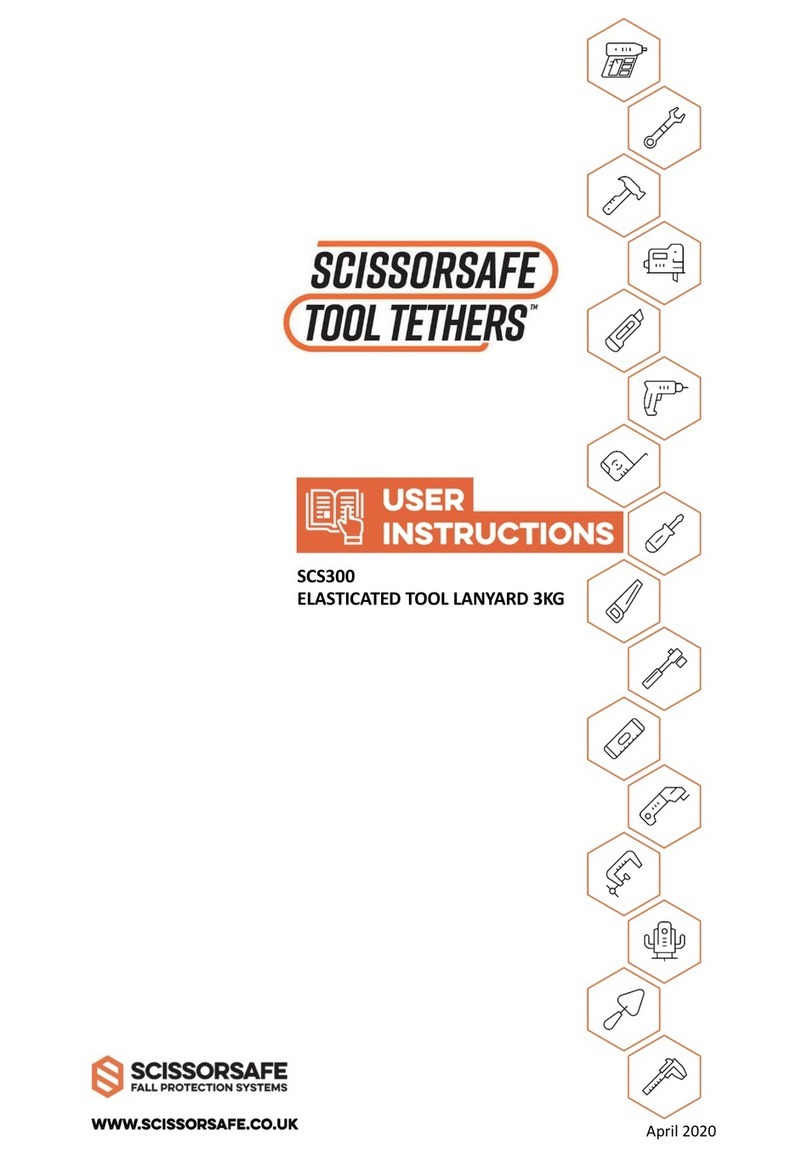
Scissorsafe
Scissorsafe SCS300 User instructions

Bradley
Bradley S19-788 Installation
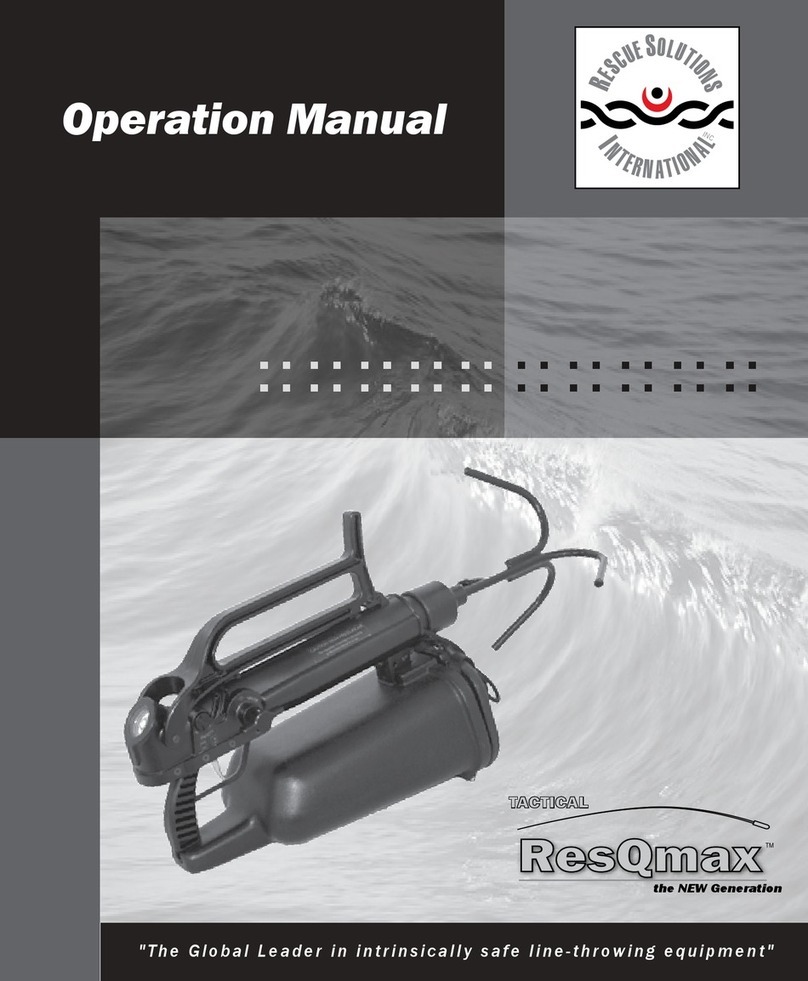
Rescue Solutions International
Rescue Solutions International Tactical ResQmax Operation manual

FALL SAFE
FALL SAFE FS881 instruction manual

Innotech
Innotech TAURUS BEF Series quick start guide

Petzl
Petzl Laser Speed S manual
